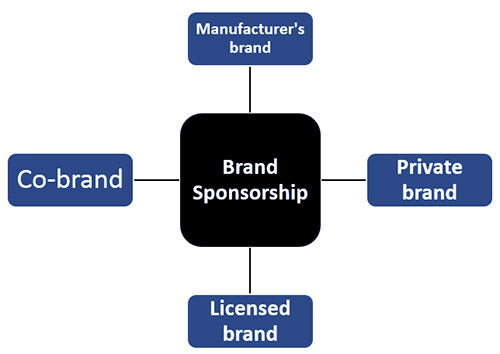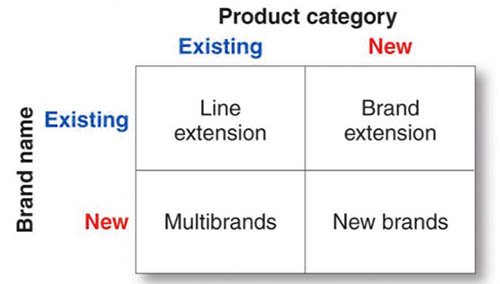Branding consists of a set of complex branding decisions. Major brand strategy decisions involve brand positioning, brand name selection, brand sponsorship and brand development.
Before going into the four branding decisions also called brand strategy decisions, we should clarify what a brand actually is. A brand is a company’s promise to deliver a specific set of features, benefits, services, and experiences consistently to buyers. However, a brand should rather be understood as a set of perceptions a consumer has about the products of a particular firm. Therefore, all branding decisions focus on the consumer.
We will take a close look at each of these four branding decisions-

Branding Decisions — Brand Positioning, Brand Name Selection, Brand Sponsorship and Brand Development.
Brand Positioning — Branding Decisions
A brand must be positioned clearly in target customers’ minds. Brand positioning can be done at any of three levels:
- on product attributes
- on benefits
- on beliefs and values.
At the lowest level, marketers can position a brand on product attributes. Marketing for a car brand may focus on attributes such as large engines, fancy colors, and sportive design. However, attributes are generally the least desirable level for brand positioning. The reason is that competitors can easily copy these attributes, taking away the uniqueness of the brand. Also, customers are not interested in attributes as such. Rather, they are interested in what these attributes will do for them. That leads us to the next level: Benefits.
A brand can be better positioned on basis of a desirable benefit. The car brand could go beyond the technical product attributes and promote the resulting benefits for the customer: quick transportation, lifestyle and so further.
Yet, the strongest brands go beyond product attributes and benefits. They are positioned on beliefs and values. Successful brands engage customers on a deep, emotional level. Examples include brands such as Mini and Aston Martin. These brands rely less on products’ tangible attributes, but more on creating passion, surprise, and excitement surrounding the brand. They have become “cool” brands.
Brand positioning lays the foundation for the three other branding decisions. Therefore, brand positioning should also involve establishing a mission for the brand and a vision of what the brand should be and do. The brand’s promise must be simple and honest.
Brand Name Selection — Branding Decisions
When talking about branding decisions, the brand name decision may be the most obvious one. The name of the brand is maybe what you think of first when imagining a brand — it is the base of the brand. Therefore, the brand name selection belongs to the most important branding decisions. However, it is also quite a difficult task.
We have to start with a careful review of the product and its benefits, the target market and proposed marketing strategies. Having that in mind, we have to find a brand name matching these things. Naming a brand is part science, part art, and certainly a measure of instinct.
Although finding the right name for a brand can be a challenging task, there are some guidelines to make it easier. Desirable qualities for a brand name include:
- It should suggest something about a product’s benefits and qualities. Think of the wadding polish “Nevr Dull”. The brand name indicates the benefit of using this product: the treated metal will never be dull.
- It should be easy to pronounce, recognize, and remember. iPod and Nike are certainly better than “Troglodyte Homonculus” — a clothing brand.
- The brand name should be distinctive so that consumers don’t confuse it with other Rolex and Bugatti are good examples.
- It should also be Think of Amazon.com, which began as an online bookseller but chose a name that would allow expansion into other categories. If Amazon.com had chosen a different name, such as books.com, it could not have extended its business that easily.
- The brand name should translate easily into foreign languages. The Ford Pinto line had some struggles in Brazil, seeing as it translated into “tiny male genitals”. Or the Mitsubishi Pajero, which means in Spanish “man who plays with himself and enjoys it a bit too much”. More famous: Coca-Cola reads in Chinese as “female horse stuffed with wax”.
- It should be capable of registration and legal protection. In other words, it m not infringe on existing brand names.
Worthy of note is the fact that brand name preferences are changing continuously. After a decade of choosing quirky names (such as Yahoo!, Google) or fictional names, today’s style is to build brands around names that carry real meaning. For instance, names such as Blackboard, a school software, make sense. However, with more and more brand names and trademark applications, available new names can be hard to find. Choosing a brand name is not enough. It also needs to be protected. Many firms attempt to build a brand name that will eventually become identified with a product category. Examples of these names include Kleenex, Tip-ex, and Jeep. However, their success can also quickly threaten the company’s rights to the name. Once a trademark becomes part of the normal language (called “genericization”), it is not protected anymore. For that reason, many originally protected brand names, such as aspirin, Walkman (by Sony) and many other names are not protected anymore.
Brand Sponsorship — Branding Decisions
Branding decisions go beyond deciding upon brand positioning and brand name. The third of our four branding decisions is the brand sponsorship. A manufacturer has four brand sponsorship options.

Branding Decisions — Brand Sponsorship Options A product may be launched as a manufacturer’s brand. This is also called national brand. Examples include Kellogg selling its output under the own brand name (Kellog’sFrosties, for instance) or Sony (Sony Bravia HDTV).
The manufacturer could also sell to resellers who give the product a private brand. This is also called a store brand, a distributor brand or an own-label. Recent tougher economic times have created a real store-brand boom. As consumers become more price-conscious, they also become less brand-conscious and are willing to choose private brands instead of established and often more expensive manufacturer’s brands. Also, manufacturers can choose licensed brands. Instead of spending millions to create own brand names, some companies license names or symbols previously created by other manufacturers. This can also involve names of well-known celebrities or characters from popular movies and books. For a fee, they can provide an instant and proven brand name. For example, sellers of children’s products often attach character names to clothing, toys and so on. These licensed character names include Disney, Star
Wars, Hello Kitty and many more. Finally, two companies can join forces and co–brand a product. Co-branding is the practice of using the established brand names of two different companies on the same product. This can offer many advantages, such as the fact that the combined brands create broader consumer appeal and larger brand equity. For instance, Nestle uses co-branding for its Nespresso coffee machines, which carry the brand names of well-known kitchen equipment manufacturers such as Krups, DeLonghi, and Siemens.
Brand Development — Branding Decisions
Branding decisions finally include brand development. For developing brands, a company has four choices: line extensions, brand extensions, multi-brands or new brands.

Branding Decisions — Brand Development Options
Line extension refers to extending an existing brand name to new forms, sizes, colors, ingredients or flavors of an existing product category. This is a low-cost, low-risk way to introduce new products. However, there are the risks that the brand name becomes overextended and loses its specific meaning. This may confuse consumers. An example for line extension is when Coca-Cola introduces a new flavor, such as diet cola with vanilla, under the existing brand name.
The brand extension also assumes an existing brand name but combines it with a new product category. Thus, an existing brand name is extended to a new product category. This gives the new product instant recognition and faster acceptance and can save substantial advertising costs for establishing a new brand. However, the risk that the extension may confuse the image of the main brand should be kept in mind. Also, if the extension fails, it may harm consumer attitudes toward other products carrying the same brand name. For this reason, a brand extension such as Heinz pet food cannot survive. But other brand extensions work well. For instance, Kellog’s has extended its Special K healthy breakfast cereal brand into a complete line of cereals plus a line of biscuits, snacks and nutrition bars.
Multi-brands means marketing many different brands in a given product category. P&G (Procter & Gamble) and Unilever are the best examples for this. In the USA, P&G sells six brands of laundry detergent, five brands of shampoo and four brands of dishwashing detergent. Why? Multibranding offers a way to establish distinct features that appeal to different customer segments. Thereby, the company can capture a larger market share. However, each brand might obtain only a very small market share and none may be very profitable.
New brands are needed when the power of existing brand names is waning. Also, a new brand name is appropriate when the company enters a new product category for which none of its current brand names are appropriate.












